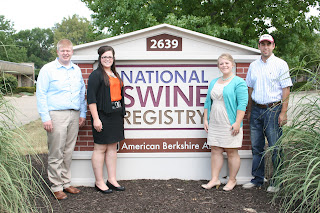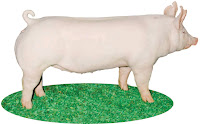Recently, Justin Fix, Ph.D., Vice
President of Global Technical Service for the National Swine Registry,
attended the joint venture signing ceremony between Whiteshire Hamroc LLC and
Tangrenshen Co. Ltd. The ceremony was held to celebrate the next step in the
partnership between these two companies – the construction of an international
genetic research and development facility in Northeast Indiana. Whiteshire
Hamroc LLC, a genetics company located in Albany, Ind., has been a long-time
member of NSR and utilizes STAGES™ for their genetic program. Tangrenshen Co.
Ltd. is the operating partner behind Meishan Whitshire – the first
Chinese-based joint venture to record U.S. derived pigs born in China with NSR.
The new research and genetic
facility will participate in the STAGES™ genetic evaluation system and will
quickly become one of the premier purebred herds in the world. In addition to
the research, training will be provided for both domestic and international
swine farm managers and workers to enhance the implementation and success of
genetic programs.
Dr. Fix was invited to speak on
behalf of NSR about the genetic and scientific benefits a facility like this
will provide to all involved.
To read the official press release from
Whiteshire Hamroc regarding the joint venture, please see below.
 |
| Justin Fix, Ph.D., discusses the benefits of the new facility with attendees. |
 |
| Pictured (l to r): Mr. Darick Wong, Vice Chairman of the Boar of Directors, Tangrenshen, and Chairman of the new farm; Dr. Brian Richert, Associate Professor, Purdue University; Dr. Ron Brock, Area Veterinarian, USDA; Dr. Justin Fix, VP of Global Technical Service, NSR; Dr. Allan Schinckel, Professor, Purdue University; and Dr. Mike Lemmon, Owner, Whiteshire Hamroc. |
International Research & Development
Farm to be Located in NE Indiana U.S. Company Signs Joint Venture Agreement
with Chinese Partner
Whiteshire Hamroc LLC, a Noble County Indiana swine genetics
company, announces a joint venture cooperation with Tangrenshen Co. Ltd., an
integrated pork and feed company in Hunan Province, China, to build an
international research and development farm in Northeast Indiana. A joint
venture signing ceremony will be held on June 9th, 2012 at the Kendallville
Event Center beginning at 10:30 AM.
“This new facility is to be the first international swine
research and development farm for both the United States and China,” said
Michael Lemmon, CEO of Whiteshire Hamroc LLC. “Employees will perform genetic and
production research on traits and techniques that will be specifically utilized
in genetic improvement programs for farms both in the United States and China,”
Lemmon added.
The research center will double as a training ground for
farm managers from China. Not only will they learn about new genetic and
production techniques/technology, but will also receive management training.
“The instruction will be focused on developing more effective, successful
production teams and improving efficiency on the farms in China, which is the
world’s largest producer and consumer of pork.” explained Lemmon.
According to Scott Lawrence of Whiteshire Hamroc, other U.S.
swine genetics companies will assist in providing genetic components and
guiding the research and development projects at the new facility. “The partners
in PureTek Genetics LLC will provide valuable genetic assets and other
assistance with this project,” said Lawrence. Along with Whiteshire Hamroc,
PureTek Genetics members include Tempel Genetics Inc. and Shaffer Superior
Genetics Inc. of Indiana, and Cedar Ridge Farms Inc. of Illinois. “The PureTek
Genetics LLC team will provide the largest purebred genetic base in the world
for further development and testing on this new research farm. Tangrenshen and
their Chinese customers will benefit directly from PureTek’s combined efforts
toward genetic improvement,” Lawrence added.
Local Impact
Locally, the new research and development farm will generate
at least 25 long term jobs and well over 100 short term construction jobs.
Local vendors, veterinarians, businesses and contractors will have the opportunity
to provide goods and services to the project. The property taxes generated are
estimated to be significantly higher than those currently being paid on the
eventual property where the farm will be built. Local hotels, restaurants and
retailers will benefit from the steady stream of Chinese visitors that will
come to this facility for training, selection of animals, or touring the state
of the art facilities. “In short,” says Lemmon, “Northeast Indiana will become
a destination for Chinese people that are involved with the most important
agricultural product in China… swine.”
Background
In 2008, Whiteshire Hamroc LLC signed its first long term
joint venture agreement with Tangrenshen Co. Ltd. With this original agreement,
Whiteshire Hamroc agreed to provide technologies crucial to a successful production
system including swine genetics, building systems, and production protocols to
its Chinese partner. Since that time, the 1200-sow Meishen Whiteshire farm has
been constructed in Zhuzhou, Hunan Province, China. This joint venture
production system has been in production since the fall of 2008, and features
Whiteshire’s patented AirWorks buildings.
The Meishen Whiteshire farm has been populated with
Whiteshire Hamroc breeding stock from the United States. Production has been
ongoing and currently approaches the same levels and quality of production as Whiteshire’s
farms in the United States. Meishen Whiteshire is the first foreign swine farm
to receive U.S. pedigrees and registrations from the National Swine Registry in
West Lafayette, IN. In addition, the Meishen Whiteshire Farm was recognized as
one of China’s top Nucleus Farms in 2011.
Sales of the purebred breeding pigs from the Meishen
Whiteshire farm have been excellent and demand for breeding pigs has resulted
in the development of a second Meishen 1200-sow farm in Hebei Province, China.
The construction of this second farm has already started and should be ready to
accept a new group of Whiteshire pigs from the United States by the end of 2012.
CONTACT:
Scott Lawrence
Whiteshire Hamroc, LLC
4728 N 200 W
Albion, IN 46701
260-636-7304 ext 111
slwarence@whiteshirehamroc.com




































